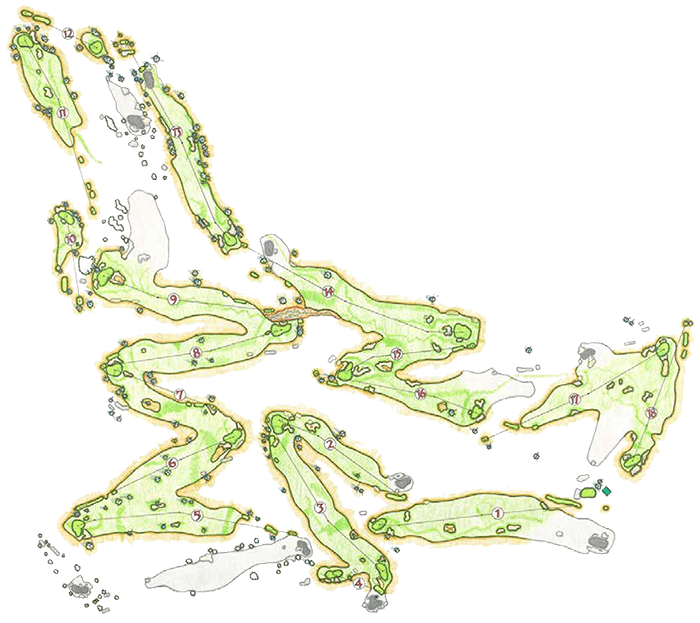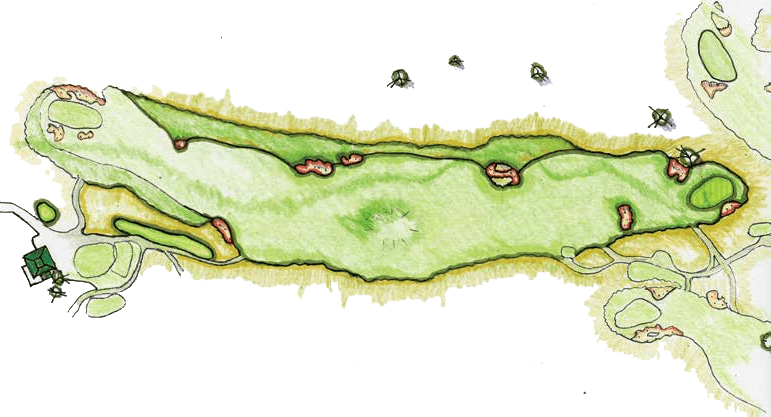Craddock Hole #1
Par 5 • 555 • 490 • 455 • 425
This short par 5 gives everyone a chance to jump start their round with this gettable hole. Your mind
will tell you to stay right (the Line of Charm) but driving left will give you a better angle to go
for the green in two shots.
The real challenge starts as you play into the ever-narrowing fairway avoiding the big fore bunker
about 50 yards right of the green and the left greenside bunker. The green is mostly a punch bowl
except for the very back. Sideboards can be used effectively here to bring errant shots back to the
middle of the green.
Craddock Hole #2
Par 4 • 355 • 345 • 330
A relatively short hole plays uphill through the sage to a large flowing green. A good target off the
tee is short of the large centerline bunker. This lines you up to play straight into the narrow
green that opens and widens toward the back.
Avoid long and left on your approach shot as the green falls off severely in this area.
Craddock Hole #3
Par 4 • 475 • 425 • 390
This hole was envisioned by architect Dan Hixson within seconds of standing on what is now the teeing
area. Drive away, but if you are a long hitter, you may want to lay back and stay short of the
nature swale cutting across the fairway at 165 yards from the green. Yes, you will have a lot longer
shot into the green, but you will be able to see the green. And, the hole is built to accept run-up
shots as easily as any high lofted shot. Any approach with pace that clears the fore-bunker 30 yards
short of the green and right should naturally tumble left towards the green.
Craddock Hole #4
Par 3 • 125 • 120 • 110
The 4th is the shortest hole on either course at 125 yards from the tips. The putting surface is
hidden and surrounded by three bunkers and relatively close native sage. This hole can fool you if
you don’t pay attention to the wind.
This is quite possibly the best view on both Hankins and Craddock. With Camp Creek and the grassy
hills to the south, the big valley to the east, forests to the north and at least seven other greens
in view, it is hard to beat.
Craddock Hole #5
Par 4 • 520 • 470 • 410
This tee shot plays into a thumb of fairway before it combines with the larger fairway complex that
is continuous for six more holes. Be careful off the tee because even though it isn’t a narrow
fairway, both sides slope away from the center. The second shot is wide open with a large swale
about 90 yards in front of the green. If the pin is left behind the bunker, the best angle is to
come in from the right.
Craddock Hole #6
Par 4 • 405 • 380 • 345
This 6th hole lies along the north side of the large fairway that is connected to the previous hole,
and the 12th hole on the Hankins course. The fairway slopes hard left to right but the best angle to
come into the green is from the left. Like all the holes with the shared fairways, being in the
short grass does not guarantee an easy approach shot. If your tee shot is right, you will have to
carry a nasty sage patch and a bunker to the green.
This is the shared green with #11 Hankins, but most people never realize it is the same green due to
the completely different angle and slope of approach. Here it has only the skyline behind it.
Craddock Hole #7
Par 3 • 260 • 225 • 200
This is by far the longest par 3 on the course with back tees playing 260 yards and 200 yards from
the front. The hole drops almost 40 feet in elevation. Think of this as a par 3 and a half, so if
you make a three, you can do half a birdie dance. We’d like to think that building two holes with a
wide difference in length – 120 to 260 yards – in the first two par 3s on the Craddock course
creates a far more interesting course than building two holes at 190 yards.
The best play is to hit something low and out to the left and let the slope feed the ball to the
green. This green has plenty of undulating areas, but generally does not break as much as you think.
Craddock Hole #8
Par 4 • 445 • 420 • 350
The setup gives all golfers a chance to stretch his or her tee ball way down the hill. The hidden
driving zone has no surprises, only favorable bounces, lots of roll and a beautiful view.
Do not let the McVeigh Homestead and the wetland left of the green distract you as it can be a hard
approach shot. The long narrow green is guarded by a small bunker and another one on the back left.
It is possible to bounce one around the right side of the front bunker to reach some back pin
locations.
Craddock Hole #9
Par 4 • 495 • 425 • 350 • 305
Playing left on this hole leaves a simple approach angle for those who do not have a chance to reach
the green.
Remember, this is much more uphill than it looks. The right side pin position has ‘sucker’ written
all over it…you’ve been warned.
Craddock Hole #10
Par 3 • 205 • 160 • 120
It can be played safe to the right with a wide gentle approach into a punchbowl on the right half of
the green. But like the last hole, the challenging pin here is on the left. The front left bunker
and the big bunker behind the green create a shallow target.
Craddock Hole #11
Par 4 • 445 • 385 • 320
The 11th plays uphill into its own little theatre shaped valley. It is a stout up hiller with one of
the more undulating greens. Some of those slopes can help you if you play them correctly.
There is a line of four bunkers from the centerline-driving bunker laid out diagonally to the right
side of the green. Unless you can hit a very long draw off the tee to the left of this bunker, you
will eventually have to cross the line to get to the green.
Craddock Hole #12
Par 3 • 190 • 155 • 135
Overall this is the highest hole in elevation on the course. The bunkerless par 3 has plenty of
things to avoid. Don’t be left, right or long as those are not the places to be. Short is best if
you are going to miss, with an uphill pitch shot awaiting.
Craddock Hole #13
Par 5 • 550 • 520 • 475
This par 5 shares the tee box with the 7th hole on the Hankins course, which is also the highest
point on the course at 4,887 feet above sea level. In fact, this is the highest point for golf in
the state of Oregon.
This is one of the better tests of driving with a tilted fairway, a large bunker on the left and
native grasses close on the right. With the fairway mowed out to the trees on the left, this hole
will have some of the most creative recovery shots on the course.
Craddock Hole #14
Par 5 • 570 • 530 • 445
Here, the routing transitions from the upper forest area back into the meadows. The straightaway par
5 has plenty of width, especial closer to the green. Long hitters will relish scoring opportunities
with these back-to-back par 5s.
The center front bunker dictates everything as the slopes off the back edge of it carry well onto the
green. The day’s hole location will dictate the best approach to the green. A little tip: more putts
break towards the back of this green than most will think.
Craddock Hole #15
Par 4 • 315 • 290 • 275
The narrow landing zone off of this tee makes pulling a shorter club a real wise choice…but who comes
all the way to Eastern Oregon to play it safe?
The general pin locations for this hole are extremely shallow, but there is a left side board that
can be used effectively.
Craddock Hole #16
Par 4 • 410 • 365 • 290
The fairway on 16 gets progressively wider the farther you drive off the tee, beginning just past the
left fairway bunker. Favoring the left side provides the best angle into the very small green.
The smart play for most on the approach is to play to the left half of the green. The right side is
shallow with deep bunkers front and back. With the small green, there are no long putts. The right
half can be reached by using the bank to the right of the green if needed in a pinch.
Craddock Hole #17
Par 4 • 490 • 420 • 365
This is one of the strongest par 4s on the course, playing 490 yards from the back tees. It is also
one of the most beautiful holes, playing from a desert ridge into the fairway complex and sharing
the first green of the Hankins course.
The 60-yard wide fairway plays much narrower because of the slope. Depending on the day’s hole
location, positioning for your second or third approach shot is as important as length.
Even if you are playing from the middle or forward tee, it is worth a few minutes to go to the back
tees for the view.
Craddock Hole #18
Par 4 • 360 • 325 • 290
The relatively short 18th can be a relief hole after the 17th. The hole plays slightly downhill off
the tees and uphill into the approach. The best angle to most pins is from the left. It is very easy
to drive “wide right” but it takes a very precise shot to hit the green from this angle.
The final hole of the Craddock course is one of many opportunities. The opportunity to make a birdie
or a double bogey. The opportunity to show off to your buddies and win a skin, as they watch from
the porch of Egan’s Hideout. The opportunity to play safe or aggressive, a hero or a dog. We hope
you are a hero. Either way, there will be something pleasant to drink just a few minutes after the
last putt.











































